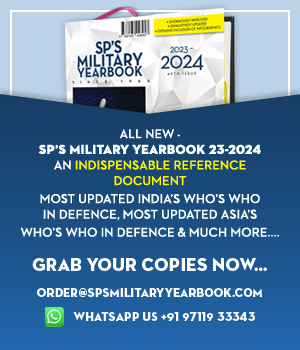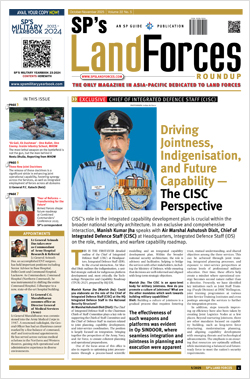INDIAN ARMED FORCES CHIEFS ON OUR RELENTLESS AND FOCUSED PUBLISHING EFFORTS
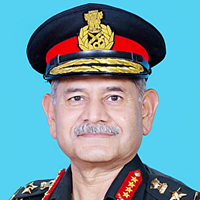
The insightful articles, inspiring narrations and analytical perspectives presented by the Editorial Team, establish an alluring connect with the reader. My compliments and best wishes to SP Guide Publications.
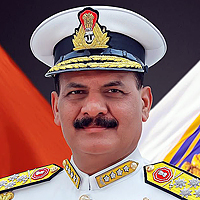
"Over the past 60 years, the growth of SP Guide Publications has mirrored the rising stature of Indian Navy. Its well-researched and informative magazines on Defence and Aerospace sector have served to shape an educated opinion of our military personnel, policy makers and the public alike. I wish SP's Publication team continued success, fair winds and following seas in all future endeavour!"

Since, its inception in 1964, SP Guide Publications has consistently demonstrated commitment to high-quality journalism in the aerospace and defence sectors, earning a well-deserved reputation as Asia's largest media house in this domain. I wish SP Guide Publications continued success in its pursuit of excellence.
- Appointments Committee of Cabinet approves one-month extension in service of Chief of the Army Staff
- Prime Minister witnesses 'Bharat Shakti' – a Tri-Services Firing and Manoeuvre Exercise in Pokhran, Rajasthan
- Interim Defence Budget 2024-25 — An Analysis
- Union Defence budget 2024
- Indian Army: In quest of greater firepower and policy recommendations for gaps
- Indian Army Annual Press Conference 2024
- Tata Boeing Aerospace Delivers 250 AH-64 Apache Fuselages, Manufactured in India
Bhairav Commando Units
The Indian Army is reshaping itself with 'Rudra' brigades and agile 'Bhairav' commando units, enhancing rapid-strike, drone-enabled operations while redefining the role of Special Forces in modern warfare
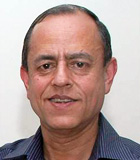 |
The Author is Former Director General of Information Systems and A Special Forces Veteran, Indian Army |

It was covered in these columns earlier that during the Kargil Vijay Diwas ceremony on July 26, 2025, the Chief of Army Staff General Upendra Dwivedi announced the concept of new 'Rudra' Brigades, highlighting their design for rapid, coordinated multi-axis offensives consistent with the Cold Start Doctrine and the ongoing modernisation; to convert the Indian Army's some 250 single-arm brigades (mostly of infantry or artillery) into self-contained, multi-arm brigades with enhanced firepower, situational awareness, and logistical efficiency.
On July 26, the Army Chief had announced the move to set up new 'Rudra' all-arms brigades, 'Shaktibaan' artillery regiments, with special 'Divyastra' surveillance and loitering munitions batteries, and the 'Bhairav' battalions. He also said all infantry battalions will now have dedicated drone platoons, which was also covered in these columns earlier.
The Rudra Brigades are to be complemented with the new 'Bhairav' Light Commando Battalions that will be agile and lean tactical units focused on rapid strikes and quick border deployments, designed to create shock impact rather than deep strategic operations.
The Rudra Brigades are to be complemented with the new 'Bhairav' Light Commando Battalions that will be agile and lean tactical units focused on rapid strikes and quick border deployments, designed to create shock impact rather than deep strategic operations. Both the Rudra Brigades and the Bhairav Light Commando Battalions signify a shift to future-ready warfare dominated by digitisation, drone surveillance, automation, and precision weaponry, enabling faster decision-making and operational mobility.
According to a recent news report, the Army is now raising the first lot of five-six 'Bhairav' light commando units, each with 250 specially trained and equipped soldiers, to enhance swift strike capabilities along the borders with Pakistan and China. Three of the first five Bhairav light commando units are coming up under the Army's Udhampur-based Northern Command; one each for the 14 Corps at Leh, 15 Corps at Srinagar, and 16 Corps at Nagrota. The fourth Bhairav light commando unit is for the desert terrain of the western sector and the fifth in the hilly terrain of the eastern sector.
Army is now raising the first lot of five-six 'Bhairav' light commando units, each with 250 specially trained and equipped soldiers, to enhance swift strike capabilities along the borders with Pakistan and China.
The 11.5-lakh strong Army is drawing manpower for these 'Bhairav' light commando units from its regular infantry battalions, which number 415, under the "save and raise" concept without fresh troop accretions. Much smaller and agile than infantry battalions, the 'Bhairav' light commando units are to be equipped with the latest weapons, gadgets and drones. They will be geared for speed, flexibility and high-impact tactical operations, according to the newspaper reports. These units will be in addition to the Army's 10 Para (Special Forces) and five SF Para (Airborne) battalions, each of which have 620 soldiers selected after arduous training, and are equipped with a wide array of specialised weapons and equipment.
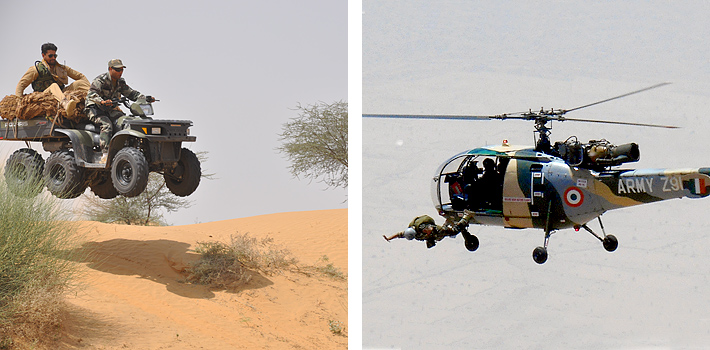
The overall plan is to eventually raise 23 Bhairav Light Commando Units. Ghatak Platoons of Infantry Battalions will continue as before. For the manpower of the 23 Bhairav Light Commando Units, the 415 Infantry Battalions are to shed manpower of 11 soldiers per battalion while the officers and JCO's vacancies will be shared within the Army. According to news reports of April 14, 2025, the Indian Army is currently facing a shortage of over one lakh personnel, including officers and soldiers. Obviously, all infantry battalions are also facing manpower shortage, which impinges specifically on their capability when deployed widely dispersed on the LoC/IB and the LAC. Manpower shortages is a recurring phenomenon which needs to be addressed permanently. But the Indian Army must also ensure that extraneous/unauthorised attachment of soldiers from infantry battalions in higher HQ and other duties is eliminated.
Army is drawing manpower for these 'Bhairav' light commando units from its regular infantry battalions, which number 415, under the "save and raise" concept without fresh troop accretions.
Though meant for special clandestine missions in high-risk environments, usually behind enemy lines, the Army's Para (Special Forces) units are being used for tactical operations on our own side of the border. An unnamed source quoted in the newspaper report said, "The 'Bhairav' light commando units, each with seven-eight officers, are also meant to "relieve" Special Forces, who can then concentrate on their more critical tasks."The 'Bhairav' light commando units will undergo specialised training for two-three months in their respective regimental centres and then be attached to the Special Forces units in their respective theatres for another month for advanced training".
The mention that these 'Bhairav' light commando units will undergo specialised training for two-three months in their "respective regimental centres" gives the impression that they will be assigned to certain Infantry Regiments, who will also be assigned the responsibility to select and train manpower replacements required in future – something like manpower being provided by infantry to specific Rashtriya Rifles (RR) battalions. It is also unclear at this stage what will be the tenure of individuals serving in these 'Bhairav' light commando units, since these units will be based in specific theatres/regions.
The overall plan is to eventually raise 23 Bhairav Light Commando Units.
Sub-conventional capacity has become the currency of geopolitical power play to further individual national interests; covert extension of foreign policy. Sub-conventional warfare including use of irregular forces, within the larger construct of hybrid war, is being practiced by nations big and small. Chances of conventional war are small compared to sub-conventional wars which are ongoing affairs.It is a dirty war without borders and morality. China's concept of 'Unrestricted Warfare' and strategy of 'Deep Coalitions' affects India seriously, for which India must develop counters. India has a strategic deficit vis-à-vis China and Pakistan in the sub-conventional segment of conflict. Indian response has largely been reactive and / or one-time signals.
To this end, it is good to read that the 'Bhairav units are also meant to "relieve' Special Forces being used for mere tactical tasks, who can then concentrate on more critical tasks. Special Forces provide a host of low-cost options to the government, including for politico-military missions at strategic level. The tasks of Army's Special Forces should be primarily trans-border. Way back in 2001, K.P.S. Gill, former DGP Punjab said, "Unless our Special Forces go for trans-border operations in the mantle of R&AW, the Army will continue to remain on the receiving end."
Finally, the million-dollar question is will India deploy the Army's Special Forces on trans-border operations, direct as well as clandestine, in the manner they should be or will they continue to be deployed on our side of the border on mere tactical operations.




